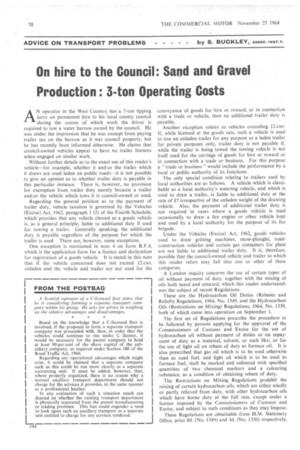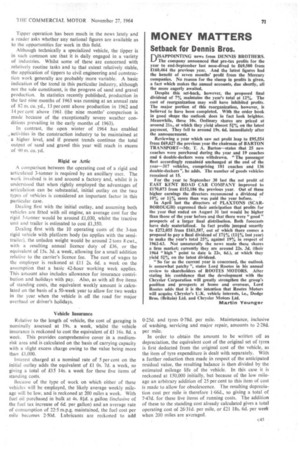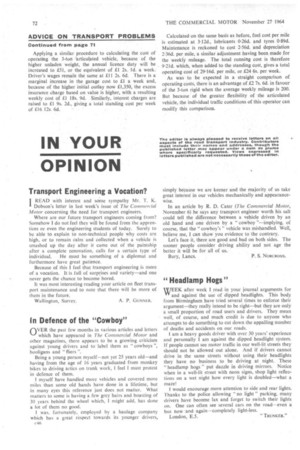On hire to the Council: Sand and Gravel Production : 3-ton Operating Costs
Page 72

Page 73

Page 74

If you've noticed an error in this article please click here to report it so we can fix it.
AN operator in the West Country has a 7-ton tipping lorry on permanent hire to his local county council during the course of which work the driver is required to tow a water barrow owned by the council. He was under the impression that he was exempt from paying trailer tax on the barrow as it was council property, but he has recently been informed otherwise. He claims that council-owned vehicles appear to have no trailer licences when engaged on similar work.
Without further details as to the exact use of this reader's vehicle—for example, whether it and/or the trailer which it draws are used laden on public roads—it is not possible to give an opinion as to whether trailer duty is payable in this particular instance. There is, however, no provision for exemption from trailer duty merely because a trailer and/or the vehicle which tows it is council-owned or used.
Regarding the general position as to the payment of trailer duty, vehicle taxation is governed by the Vehicles (Excise) Act, 1962, paragraph 1(2) of the Fourth Schedule, which provides that any vehicle classed as a goods vehicle is, as a general principle, liable to additional duty if used for towing a trailer. Generally speaking, the additional duty is payable regardless of the purpose for which the trailer is used There are, however, some exceptions.
One exception is mentioned in note 4 on form R.F.4, which is the application form for a licence and declaration for registration of a goods vehicle. It is stated in this note that if the vehicle concerned does not exceed 12 cwt. unladen and the vehicle and trailer are not used for the conveyance of goods for hire or reward, or in connection with a trade or vehicle, then no additional trailer duty is payable.
Another exception relates to vehicles exceeding 12 cwt. If, while licensed at the goods rate, such a vehicle is used to tow an unladen trailer for any purpose or a laden trailer for private purposes only, trailer duty is not payable if, while the trailer is being towed the towing vehicle is not itself used for the carriage of goods for hire or reward or in connection with a trade or business. For this purpose a "trade or business" would include the performance by a local or public authority of its functions.
The only special condition relating to trailers used by local authorities are as follows. A vehicle which is classifiable as a local authority's watering vehicle, and which is used to draw a trailer, is liable to additional duty at the rate of £7 irrespective of the unladen weight of the drawing vehicle. Also, the payment of additional trailer duty is not required in cases where a goods vehicle is used occasionally to draw a fire engine or other vehicle kept and used by a local authority for the purpose of its fire brigade.
Under the Vehicles (Excise) Act, 1962, goods vehicles used to draw gritting machines, snow-ploughs, roadconstruction vehicles and certain gas containers for plant are not liable to additional trailer duty. It is, therefore, possible that the-council-owned vehicle and trailer to which this reader refers may fall into one or other of these categories.
A London inquiry concerns the use of certain types of oil without payment of duty, together with the mixing of oils both taxed and untaxed, which this reader understands was the subject of recent Regulations.
These are the Hydrocarbon Oil Duties (Rebates and Reliefs) Regulations, 1964, No. 1349, and the Hydrocarbon Oils (Restrictions on Mixing) Regulations, 1964, No. 1350, both of which came into operation on September 1.
The first set of Regulations prescribe the procedure to be followed by persons applying for the approval of the Commissioners of Customs and Excise for the use of hydrocarbon oil without payment of duties or on repayment of duty as a material, solvent, or such like; or for the use of light oil on rebate of duty as furnace oil. It is also prescribed that gas oil which is to be used otherwise than as road fuel, and light oil which is to be used as furnace fuel, shall be marked and coloured with specified quantities of two chemical markers and a colouring substance, as a condition of obtaining rebate of duty.
The Restrictions on Mixing Regulations prohibit the mixing of certain hydrocarbon oils, which are either wholly or partly relieved from duty, with other hydrocarbon oils which have borne duty at the full rate, except under a licence imposed by the Commissioners of Customs and Excise, and subject to such conditions as they may impose.
These Regulations are obtainable from H.M. Stationery Office, price 8d. (No. 1349) and 3d. (No. 1350) respectively. Tipper operation has been much in the news lately and a reader asks whether any national figures are available as to the opportunities for work in this field.
Although technically a specialized vehicle, the tipper is in such common use that it is daily engaged in a variety of industries. Whilst sonic of these are concerned with relatively routine tasks and to that extent relatively stable, the application of tippers to civil engineering and construction work generally are probably more variable. A basic indication of the trend in this particular industry, although not the sole constituent, is the progress of sand and gravel production. In statistics recently published, production in the last nine months of 1963 was running at an annual rate of 82 m. cu. yd., 13 per cent above production in 1962 and 14 per cent above 1961 (the nine months' comparison is made because of the exceptionally severe weather conditions prevailing in the early months of 1963).
In contrast, the open winter of 1964 has enabled activities in the construction industry to be maintained at a higher level, and if present trends continue the total output of sand and gravel this year will reach in excess of 90 iii. cu. yd.
Rigid or Attic A comparison between the operating cost of a rigid and articulated 3-tonner is required by an ancillary user. The work involved is in and around a factory and, whilst it is understood that when rightly employed the advantages of articulation can be substantial, initial outlay on the two types of vehicles is considered an important factor in this particular case.
Dealing first with the initial outlay, and assuming both vehicles are fitted with oil engine, an average cost for the rigid 3-tonner would be around £1,030, whilst the tractive Unit and trailer is estimated to cost £1,350.
Dealing first with the 10 operating costs of the 3-ton rigid vehicle with platform body (as applies with the semitraiter). the unladen weight would be around 2 tons 8 cwt., with a resulting annual licence duty of £36, or the equivalent of 15s. 3d. a week, allowing for a small addition relative to the carrier's licence fee. The cost of wages to the employer is reckoned at £11 2s. 6d. a week on the assumption that a basic 42-hour working week applies. This amount also includes allowance for insurance contribution and holidays with pay. Also, as with all five items of standing costs, the equivalent weekly amount is calculated on the basis of a 50-week year to allow for two weeks in the year when the vehicle is off the road for major overhaul or driver's holidays.
Vehicle Insurance Relative to the length of vehicle, the cost of garaging is nominally assessed at 19s. a week, whilst the vehicle insurance is reckoned to cost the equivalent of £1 16s. 8d. a week. This provides comprehensive cover in a mediumrisk area and is calculated on the basis of carrying capacity with a slight excess charge owing to the value being more than £1,000.
Interest charged at a nominal rate of 5 per cent on the initial outlay adds the equivalent of £1 Os. 7d. a week, so giving a total of £15 14s. a week for these five items of standing costs.
Because of the type of work on which either of these vehicles will be employed, the likely average weekly mileage will be low, and is reckoned at 200 miles a week. With fuel oil purchased in bulk at 4s. ald. a gallon (inclusive of the fuel tax increase of 6d. per gallon) and an average rate of consumption of 22.5 m.p.g. maintained, the fuel cost per mile becomes 2.50d. Lubricants are reckoned to add 0.25d. and tyres 0-78d. per mile. Maintenance, inclusive of washing, servicing and major repair, amounts to 2.28d. per mile.
In order to obtain the amount to be written off as depreciation, the equivalent cost of the original set of tyres is first deducted from the original cost of the vehicle, as the item of tyre expenditure is dealt with separately. With a further reduction then made in respect of the anticipated residual value, the resulting balance is then divided by the estimated mileage life of the vehicle. In this case it is reckoned at 150,000 initially, but because of the low mileage an arbitrary addition of 25 per cent to this item of cost is made to allow for obsolescence. The resulting depreciation cost per mile is therefore 1.66d., so giving a total of 7.47d. for these five items of running costs. The addition of these to the standing cost already calculated gives a total operating cost of 26.31d. per mile, or £21 18s. 6d. per week when 200 miles are averaged.
Applying a similar procedure to calculating the cost of operating the 3-ton -articulated vehicle, because of the higher unladen weight, the annual licence duty will be _ increased to £51, or the equivalent of £1 2s. Id. a week. Driver's wages remain the same at £11 2s. 6d. There is a marginal increase in the garage cost to £1 a week and, because of the higher initial outlay now £1,350, the excess insurance charge based on value is higher, with a resulting weekly cost of £1 18s. 9d. Similarly, interest charges are raised to £1 9s. 2d., giving a total standing cost per week of £16 12s. 6d.
Calculated on the same basis as before, fuel cost per mile is estimated at 3-12d., lubricants 0-26d. and tyres 0-89d. Maintenance is reckoned to cost 2-56d. and depreciation 2.36d. per mile, a similar adjustment having been made for the weekly mileage. The total running cost is therefore 9.21d. which, when added to the standing cost, gives a total operating cost of 29.16d. per mile, or £24 6s. per week.
As was to be expected in a straight comparison of operating costs, there is an advantage of £2 7s. 6d. in favour of the 3-ton rigid when the average weekly mileage is 200. But because of the greater flexibility of the articulated vehicle, the individual traffic conditions of this operator can modify this comparison.
















































































































